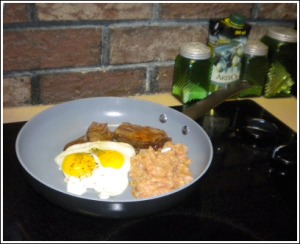
Less than 1/10 of an inch (near 529 and Huffmeister), but the new rain gauge is ready to take on more.
Friday has brought another tranquil morning, and as I’m on vacation I’m going to enjoy it to the fullest.
This morning when I got up to take Annie out, there was a light rain coming down, so I was more ready to go out that she was. Yesterday, I had put up a rain gauge. The farm kid in me wanted a rain gauge to go along with my new garden. There’s a perfect post right at the garden gate that’s right out in the open away from the influence of the surrounding trees. Because it was still almost dark at that time, I couldn’t see how much precipitation–if any–had collected in the gauge.
I went back inside, but soon was ready for something to eat. I don’t know what it is–on a work day morning, I’m not hungry when I get up, but when I have a day off, I feel like eating and usually make a substantial breakfast.
Yesterday I had made chile colorado and cooked some pinto beans. (I’ll post the recipe for chile colorado later.) I had wanted to make frijoles a la charra (ranch-style beans), but I didn’t have all the ingredients. Anyway, when it comes to cooking, sometimes simple is better. Here is what I did:
Home-cooked Pinto Beans
2 cups dry pinto beans (Wash the beans in a colander, place in a large bowl, and add at least twice as much water as beans. Let the beans soak for at least 4 hours, but overnight is even better.
When the beans are soaked and ready to cook:
1 medium onion chopped
1 cloves garlic (smash the garlic with the side of a big knife and then finely mince
2 tablespoons olive oil.
Heat the olive oil in a 2-quart pot and add the chopped onions. Sauté the onions until they begin to change color, and then add the garlic. (Garlic tends to burn if you cook for the same time as the onion.)
Once the vegetables are sautéd, dump the beans and water into the pot. Add more water for a total of 1 1/2 quarts. The water should be an inch or two below the rim of the pot.
At this point add a bit of ham, bacon, or salt port. I had some thin deli ham, so I put in a couple slices, not very much at all.
Turn up the heat to medium-high, put the lid on the pot, and bring the water to a boil. After the liquid is boiling, reduce the heat and partially cover the pot with the lid. Cook the beans at a very low simmer for at least an hour and then check on them. When the skins start to split, strain one or two beans out of the liquid and check them for doneness. If they are still grainy, they’ll need at least an hour more.
In the food processor, pulse together: 1 can of stewed tomatoes, 2 tablespoons grape jelly, and 1/3 cup ketchup.
Add this mixture to the beans before they are completely cooked and let everything finish cooking together. When the beans are completely cooked, salt and pepper to taste.
The broth is very tasty, so you could serve this as a soup, or strain the beans and serve them just as a vegetable.
 For my breakfast this morning, I decided to take advantage of what I had cooked yesterday, so I strained out about a cup of the beans and pulsed them in the food processor. Don’t overdo it, you want to keep some bean texture and not have a dip!
For my breakfast this morning, I decided to take advantage of what I had cooked yesterday, so I strained out about a cup of the beans and pulsed them in the food processor. Don’t overdo it, you want to keep some bean texture and not have a dip!
So in my non-stick frying pan, I cooked two eggs and added the beans for refried beans. Why do they call them “refried” beans? They’ve already been cooked, but “fried”? Only once. Maybe the refrying is in the method. To get the beans nice and crispy on the outside, keep turning and turning them, something like you might do with a potato pancake. Never made them? Well, keep turning the beans until they look tasty.
 The light rain let up and I went out to eat my breakfast on the patio. Once again, I feel like I’m truly on vacation. My back yard is such as pleasant place.
The light rain let up and I went out to eat my breakfast on the patio. Once again, I feel like I’m truly on vacation. My back yard is such as pleasant place.
Just to add to the peaceful environment, a pair of cardinals came to scratch in the grass and have a bit of breakfast while I was enjoying mine.
Filed under: All About H-Town (Houston), Annie and Dog Talk, House Buying, It's What I Like, Talking About Food, Weather | Tagged: Annie, bean soup, breakfast, broth, cardinal, chile colorado, cooking, farm boy, frijoles a la charra, garlic, homemade, Houston weather, onions, pinto beans, rain gauge, recipe, refried beans, vacation |




 http://jointheimpact.com
http://jointheimpact.com


Leave a comment